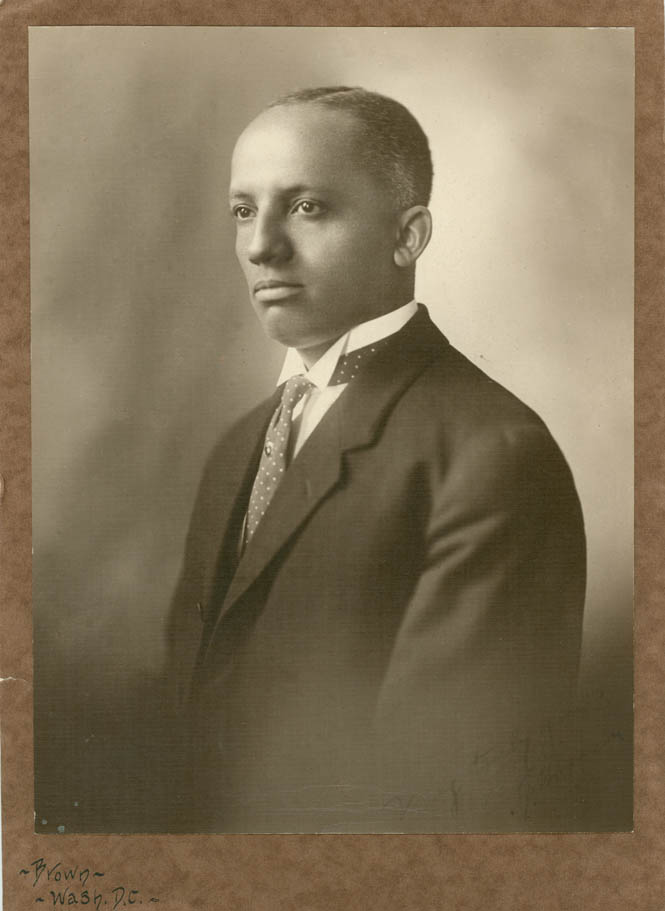
Carter G. Woodson was the son of former slaves James and Eliza Riddle Woodson. His father had helped the Union soldiers during the Civil War, and afterwards he moved his family to West Virginia where a high school for blacks was being built. Coming from a large, poor family, Carter could not regularly attend school, but through self-instruction he was able to master the fundamentals of common school subjects by the time he was 17.
In 1895, at the age of 20, Woodson entered Douglass High School where he received his diploma in less than two years. From 1897 to 1900, he began teaching in Fayette County, and he later became the principal of his own alma mater. Woodson finally received his bachelor's degree from Berea College in Kentucky. From 1903 to 1907 he was a school supervisor in the Philippines. He then attended the University of Chicago where he received his master's in 1908, and in 1912, he received his Ph.D. in history from Harvard University.
In 1915, Woodson and Jesse E. Moorland co-founded the Association for the Study of Negro Life and History (ASNLH). The organization was the platform that launched Woodson's mission to raise awareness and recognize the importance of Black history. He believed that publishing scientific history about the black race would produce facts that would prove to the world that Africa and its people had played a crucial role in the development of civilization. Thus he established a scholarly journal, The Journal of Negro History, a year after he formed the ASNLH.
Seeing the need to spread the news about Black history to the general public as well as scholars, Woodson and the ASNLH pioneered the celebration of "Negro History Week" in 1926, which has since been extended to the entire month of February. Even with the monumental duties connected with the association, Woodson still found time to write extensive and scholarly works such as “The History of the Negro Church” (1922), "The Mis-Education of the Negro" (1933) and many other books that continue to have wide readership today. Woodson's other far-reaching activities included the organization in 1920 of the Associated Publishers, the oldest African American publishing company in the United States.
Woodson is buried at Lincoln Memorial Cemetery in Suitland-Silver Hill, Md. His Washington, D.C., home has been preserved as the Carter G. Woodson Home National Historic Site.
-----------------------------------------------------------------------------------------------------------------------
THE ORANGEBURG MASSACRE
On this date, the evening of February 8, 1968, South Carolina Highway Patrol Officers open fired into an unarmed crowd of approximately 200, mostly students from the historically black South Carolina State College, who were protesting segregation at a local bowling alley. They killed South Carolina State students Samuel Hammond and Henry Smith, and 17-year old high school student Delano Middleton. Another 28 protesters were injured; most were shot in the back, as they were running from the cops.
On February 5, 1968 a group of students from South Carolina State entered the All Star Bowling Lane in Orangeburg and left peacefully after they were asked to leave. The next night more students returned and entered the bowling alley. This time there were cops waiting for them and several students were arrested.
After the arrests, more students began showing up, angry that protesters were being arrested. Police began beating student protesters with billy clubs, and that night eight students were sent to the hospital.
Over the next couple of days the tension in Orangeburg escalated. Student protesters submitted a list of demands calling for the elimination of discrimination within the community. The South Carolina governor called in the National Guard.
On the evening of February 8, 1968, students started a bonfire on the front of South Carolina State's campus in a peaceful protest. As police and firefighters attempted to put out the fire, an officer was struck by a thrown object.
South Carolina Highway Patrol Officers began firing into the unarmed crowd of roughly 200 protesters. Nine Patrol Officers fired rifles, shotguns, and revolvers at the students. Twenty-eight people were injured in the shooting; most of which were shot in the back as they were running away.
Three African American men were killed. The dead were SCSC students Samuel Hammond and Henry Smith, and local high school student Delano Middleton.
The nine cops were tried for using excessive force. All were acquitted. The only person convicted and imprisoned for the incident was Cleveland Sellers, SNCC activist, who was convicted of inciting a riot and served seven months in prison.
The Orangeburg killings received very little media coverage. The killings were the first on a U.S. college campus. Twenty-five years later, Sellers was officially pardoned by the governor of South Carolina.